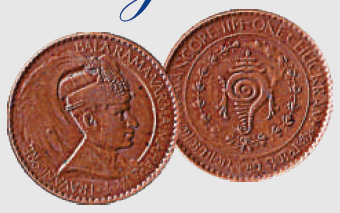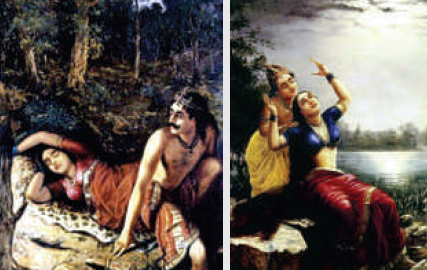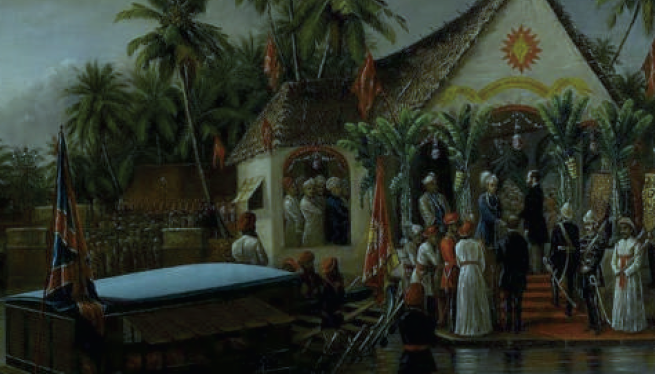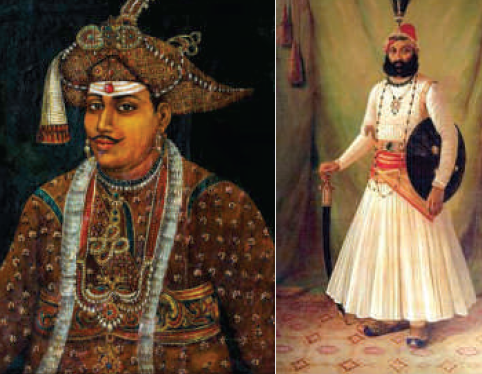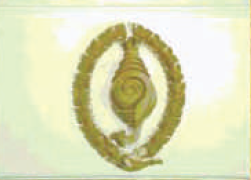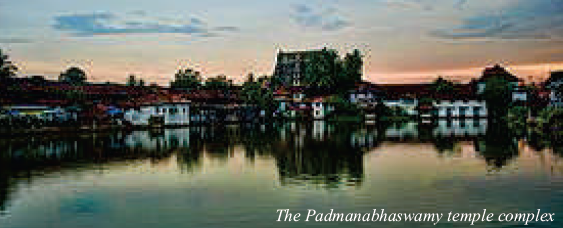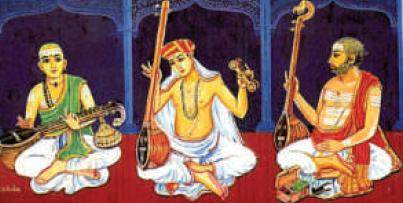The Travancore royal family
This is a collection of articles archived for the excellence of their content. Readers will be able to edit existing articles and post new articles directly |
The Travancore royal family
Patrons Of Art And Music To The Present Day
By Dr. V.K. Gardner
India Harmony Volume - 2 : Issue - 1, 2013
There comes a time in the life of nations and nascent States when the artistic endeavours of the men and women who administer power, or who are born in influential families, impact indelibly upon the cultural contours of its artistic history and alter the course of its destiny in the perceptive framework of a more comprehensive artistic idiom.
““An artist who is credited with bringing about a momentous turn in the art of India, Raja Ravi Varma inexorably influenced future generations of artists from different streams. He was the first artist to cast the Indian Gods and mythological characters in natural earthy surroundings using a European realism; a depiction adopted not only by the Indian “calendar-art”- spawning ubiquitous images of Gods and Goddesses, but also by literature and later by the Indian film industryaffecting their dress and form even today. “
Born in the princely State of Travancore as Ravi Varma of Thampuran, of Kilimanoor palace on the 29th of April, 1848, Raja Ravi Varma secured the royal patronage of Ayilyam Thurunal of Travancore at an early age and began formal training thereafter. Belonging to a distinguished family – his father, Ezhumavail Neelakanthan Bhattatiripad was an accomplished scholar and his mother, Umayamba Thampuratti, was a poet and writer whose significant scholastic contribution, Parvati Swayamvaram, an informative treatise on the Tullal dance form, was published posthumously – it was almost a foregone conclusion that Raja Ravi Varma would one day shine on the firament of Indian Fine Arts!
Trained in water painting by Rama Swami Naidu, and later in oil painting by Dutch portraitist Theodor Jenson, he achieved the acme of artistic excellence with surprising swiftness! “His dazzling oil paintings of India's ancient glory delighted turn-of-the-century India and his mass reproductions through oleography reached out to the Indian populace in an unprecedented scale” – stunning the admiring gazes of later viewers with the voluptuousness of the Indian female form depicted in such perfect contoured proportion and with such a vivid burst of colour, that the visual images remained long after the physical (and pleasurable) assault on the eyes was over! Of course the feminine form was not the only focus of his artistic attention – mythical figures, demi-gods and Gods from the Indian pantheon also peopled his arresting works of art, creating a vast canvas of artistic achievement which was as appealing as it was authentic, as arresting as it was ample in quantification.
But I digress….Let us travel back in time to that auspicious time when this illustrious artist was born and the significant forces that gave rise to his artistic “oeuvres”, culminating in works to thrill the connoisseur of art as much as they provided pleasure to the aspiring student of art!
Privileged enough to be born into a family of scholars, poets and artists, even as a young boy he filled the walls of his home with a profusion of colorful pictures of animals and vignettes from his daily life, unconsciously displaying his skill in a medium which would later acquire magnificence! His indisputable talent was noted by his uncle, Raja Raja Varma, who himself was a proponent of the famous Tanjore art form. Persevering, he gave him his first few valuable lessons in art and continued to take a further interest in his further training and education, harnessing the royal patronage of the then ruling king, Ayilyam Thirunal.
Ravi Varma had been using the indigenous paints made from leaves, flowers, tree bark and soil which his uncle Raja Raja Varma prepared for him so diligently. Came another dilemma and he was faced with the challenge of using his first set of oil paints, brought from Madras after noticing a newspaper advertisement. Excited and nervous, he handled the paints he had waited such a long time for, with a degree of trepidation!
Though fully conversant with the art of painting, he was faced with the challenge of working in a medium which was very new and the technique equally elusive in those days! Only one person in Travancore knew the technique of oil painting and that happened to be Ramaswamy Naicker of Madura, who, recognizing a potential rival in Varma, refused to teach him the knowhow! Naicker's student, Arumugham Pillai however, would actually sneak into Moodath Madam House at nightfall to share his knowledge with Varma, much against his teacher's wishes. So began a cycle of clandestine but constructive artistic instruction!
Raja Ravi Varma's sojourn to the Moodath Madam house of the Kilimanoor Palace in Thiruvananthapuram at the tender age of 14, thus proved to be a multi-faceted boon! Not only did the palace painter instruct him in the art of water painting, but Ayilyam's nurturing of his artistic perceptions also exposed him to the famous paintings of Italian painters!
Thus, with the influence of the West, Raja Ravi Varma not only acquired new materials and new techniques, completely convinced of their power and serviceability, but through self-instruction and bold experimentation, mastered the complicated art of mixing colours! He painted with a passion he had not known existed and executed works which displayed a marvellous maturity.
“He painted both portraits and landscapes and introduced new elements into Indian painting. For the first time in the annals of Indian art, he had mastered and introduced the principle of perspective, the usage of canvas and oil colours. He brought in a perfect blend of European Academic realism and the true spirit of the Indian context.”
The innumerable pictures of Gods and Goddesses painted by Raja Ravi Varma which adorn most of the Hindu homes all over India, are even today objects of mass worship! Raja Ravi Varma's own sister, Mangalabhai Tampuratti, specialised herself in painting pictures of women and children which won universal appreciation from connoisseurs of art.
Music has often been known to inspire and promote a greater artistic finesse, imbuing it with an eloquence of expression and execution which enhances its appeal. Ravi Varma's creativity was further tempered by ecstatically listening to the music of veterans, watching Kathakali performances with rapt attention, going through the manuscripts preserved in ancient families and listening to the artistic interpretations of the epics.
Ravi Varma's fame as a portrait artist soared with several important portrait commissions from the Indian aristocracy and British officials between 1870 and 1878, and the sensitivity and immense competence of this artist still remains unsurpassed! However, before his roller-coaster ride to fame and fortune began, before the plaudits rolled in, in abundant measure, another significant event took place.........
His marriage, in 1866, to Pooroouttati Naal Tampuratty of Mavelikkara Kottaram Royal family and its attendant social status brought him into contact with the British Resident at Trivandrum and opened up the avenues of greater national and international exposure!
It was the Resident who persuaded him to participate in the Fine Art Exhibition, Madras in 1873. His work titled "A Nair Lady at the Toilet" showing a pretty woman adoring her hair with a garland of jasmine was adjudged to be the best! Wooing audiences, winning the Governor's Gold Medal, feted and felicitated by Governors and kings, he shot to fame!
“The Painter Prince” as he was somewhat romantically known, had begun to brighten the horizons of artistic endeavour, both in the country whose rich cultural heritage nurtured him, and the world beyond, which beckoned to him to explore world vistas!
The recognition that Ravi Varma received in major exhibitions abroad was for his evocative portrait-based renditions, which were meticulous compositions of people, their demeanor and attires. These works finely blended the elements of the early Tanjore custom of painting Nayikas and the graceful realism of European masters.
In the year 1873 Ravi Varma became a world famous Indian painter after winning honors in the prestigious international Vienna Exhibition. Though not really qualified for the title of a Raja, when an imperial citation happened to come across in the name of Raja Ravi Varma, the appellation stuck and stayed, suitably earned! Besides portraits, and portrait-based compositions, Varma now assiduously embarked on honing an oeuvre for theatrical compositions based on Indian myths and legends!
Painting over two dozen large canvasses depicting episodes from the Mahabharata and Ramayana, he worked with an impassioned fervor, creating his best works of art!
Thus several paintings like Nala and Damayanti, Radha & Madhava, Arjuna and Subhadra, Bharata, Shantanu and Ganga, Shantanu and Matsyagandhi, Vishwamitra and Menaka, Krishria Drishtha, Radha waiting for Krishna in Brindavan, Shakuntala writing letter with two sakhis, Mitrayani & Priyamvada and Urvashi, Sleeping Beauty, Lakshmi and Saraswati, acquired spectacular new dimensions under his skilful brush.
Executed during his ceremonial stay at the palace of Baroda, where he had been especially invited in 1881 by Sir R. Madhvarao, the British Regent to the State of Baroda, to commission the ceremonial portrait of Sayajirao III, the Gaekwad of Baroda, he was actively assisted by his brother, C. Raja Raja Varma, and sister Mangalabai Tampuratty, in this artistic venture. They adorn, with pride and perfection, the regal walls of Lakshmi Vilas Palace and Museum in Baroda, side by side with a significant number of family portraits of the royal Gaekwads, also done by Raja Ravi Varma!
The various assignments from the Gaekwad of Baroda brought Ravi Varma much renown and fame! Princes from different native states of India sought his services and he was invited to Bhavnagar, Puddukkottai, Mysore, Bikaner, and Jaipur to revive pictorial art history in their states. Though born in Travancore, he was the first of a new generation of Indian artists to cross regional barriers in receiving commissions and executing paintings on a pan Indian level.
And thus it was when we visited the resplendent Palace in Mysore some 25 years ago, we were treated to a visual feast of life-sized portraits of the erstwhile Maharaja of Mysore, Sri Chamarajendra Wodeyar and members of his royal family. Adorning the Jagmohan Palace Art Gallery, they had been executed during 1885, when the artist was invited for a royal visit, given a mansion to live in and regaled with music, dances and plays every night at the royal palace! On the eve of his departure, after a richly productive three month period, the Maharaja lined up his retinue of royal elephants and asked Raja Ravi Varma to choose two, which were later sent to Kilimanoor! Such was the largesse of living and giving in those gracious times!
With oil paints applied thickly, Ravi Varma created “lustrous, impasted jewellery, brocaded textures, and subtle shades of complexions.” Though several folk and traditional art forms of India since time immemorial “subsisted as illustrations for religious narratives, yet, illusionist paintings as a medium for story telling was Ravi Varma's invention.”
There was no greater artist than Ravi Varma either during his lifetime or in Indian Art History. Tributes came in from various places and people. Perhaps the most memorable is by Dr. Abanindranath Tagore, a revered name in Indian art, "it is rare to come across men like him, artists like him.
Swathi Thirunal Varma
Privileged to belong to the same illustrious Royal family of Travancore is Sri Swathi Thirunal Varma, the Maharaja of Travancore from April 16, 1813 to December 25, 1846 and a great patron of music.
A great musician himself, Sri Swathi Thirunal Rama Varma encouraged both broad systems of Indian music, Hindustani and Carnatic music. Essentially a connoisseur of the Carnatic music tradition, he is credited with over 400 compositions in both Carnatic and Hindustani music. Some of his favorite compositions include Padmanabha Pahi, Deva Deva, Sarasijanabha and Sree Ramana Vibho.
Evincing a deep interest in music right from his childhood, Swathi Thirunal, whose education was keenly supervised by his mother, herself a musician, his father, who was a Sanskrit scholar and his aunt Maharani Gowri Parvati Bayi, tried to learn the languages in which he found good music! Fluent in an impressive number of languages including Malayalam, Marathi, Sanskrit, Hindi, Bengali, Telugu, Kannada, Tamil, Oriya and English, he even knew Persian! His education in music started with the first lessons from Karamana Subrahmania Bhagavathar and Karamana Padmanabha Bhagavathar. Later, he studied music from his English teacher Subbarao. A self-taught musician to some extent, he continued to learn music by listening to accomplished musicians and practicing himself, honing the finer points of the art! Living during the golden era of Carnatic music, this was a period when music and art were thriving in many parts of south India. The triumvirate of Carnatic music, Tyagaraja (1767–1847), Syama Sastri (1762–1827) and Muthuswami Dikshitar (1775–1835), lived and enriched music greatly through their renditions, during this period. Swati Tirunal's palace was also home to many notable musicians and artistes of the period, including the famous Thanjavur Quartet brothers, Tyagaraja's disciple Kannayya Bhagavathar, Ananthapadmanabha Goswami (a Maharashtrian singer known as Kokilakanthameru swami),Shadkala Govinda Marar, and many others.
Prince Rama Varma, the South Indian Classical Musician, who is a descendent of Maharaja Swathi Thirunal, organises the highly reputed Swathi Sangeethotsavam, a week long music festival featuring exclusively the compositions of Swathi Thirunal. This unique musical event is conducted every year from 6 to 12 January at Kuthira Malika, Trivandrum. Featuring both Hindustani and Carnatic classical music, it is conducted by His Highness Sir Rama Varma Maharaja of Travancore Trust under the helm of Prince Rama Varma. A musical odyssey to enchant music lovers, it is the culmination of the rich tradition of music and culture of the tremendous Travancore kings!

